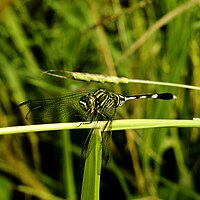
Damselfly eggs alter their development rate in the presence of an invasive alien cue but not a native predator cue
Sign Up to like & getrecommendations! Published in 2021 at "Ecology and Evolution"
DOI: 10.1002/ece3.7729
Abstract: Abstract Biological invasions are a serious problem in natural ecosystems. Local species that are potential prey of invasive alien predators can be threatened by their inability to recognize invasive predator cues. Such an inability of… read more here.
Keywords: damselfly; cue; egg; predator ... See more keywords

Conservation planning for the extraordinary and Endangered Spesbona damselfly
Sign Up to like & getrecommendations! Published in 2017 at "Journal of Insect Conservation"
DOI: 10.1007/s10841-017-9960-8
Abstract: The damselfly Spesbona angusta is one of the world’s rarest insects, is Red Listed as Endangered, and occurs today at only one known locality in the Cape Floristic Region (CFR), South Africa. It has some… read more here.
Keywords: damselfly; conservation planning; extraordinary endangered; locality ... See more keywords

Sexual conflict does not maintain female colour polymorphism in a territorial damselfly
Sign Up to like & getrecommendations! Published in 2018 at "Animal Behaviour"
DOI: 10.1016/j.anbehav.2018.04.020
Abstract: Female-limited dimorphism is commonly hypothesized to be an adaptation resulting from male harassment or sexual conflict over female mating rate. We examined whether males discriminate between female colour morphs of the beautiful Hawaiian damselfly, Megalagrion… read more here.
Keywords: damselfly; female colour; conflict; sexual conflict ... See more keywords

Stronger effects of Roundup than its active ingredient glyphosate in damselfly larvae.
Sign Up to like & getrecommendations! Published in 2017 at "Aquatic toxicology"
DOI: 10.1016/j.aquatox.2017.10.028
Abstract: Pesticides are causing strong decreases in aquatic biodiversity at concentrations assumed safe by legislation. One reason for the failing risk assessment may be strong differences in the toxicity of the active ingredient of pesticides and… read more here.
Keywords: damselfly; roundup active; toxicity; active ingredient ... See more keywords

Paracoryphagrionidae fam. nov., a pseudostigmatoid damselfly from mid-Cretaceous Burmese amber showing regular series of triangular cells (Odonata: Zygoptera: Coenagrionida)
Sign Up to like & getrecommendations! Published in 2018 at "Cretaceous Research"
DOI: 10.1016/j.cretres.2017.10.005
Abstract: Abstract Paracoryphagrionidae Zheng, Nel and Wang fam. nov., a new damselfly family based on the genus and species Paracoryphagrion deltoides Zheng, Nel and Wang gen. et sp. nov., is described from Burmese amber. Paracoryphagrionidae is… read more here.
Keywords: burmese amber; damselfly; triangular cells; zygoptera ... See more keywords

The second mesomegaloprepid damselfly (Odonata: Zygoptera) from mid-Cretaceous Burmese amber
Sign Up to like & getrecommendations! Published in 2018 at "Cretaceous Research"
DOI: 10.1016/j.cretres.2018.04.018
Abstract: Abstract The mesomegaloprepids are some of the most abundant fossil damselflies in mid-Cretaceous Burmese amber characterized by large size, brown colour and dense wing venation. Here we described a new damselfly, Cretamegaloprepus zhouae Zheng, Nel… read more here.
Keywords: damselfly; burmese amber; mesomegaloprepid damselfly; mid cretaceous ... See more keywords

Latitudinal and age-specific patterns of larval mortality in the damselfly Lestes sponsa: Senescence before maturity?
Sign Up to like & getrecommendations! Published in 2017 at "Experimental Gerontology"
DOI: 10.1016/j.exger.2017.05.008
Abstract: Abstract Latitudinal differences in life history traits driven by differences in seasonal time constraints have been widely documented. Yet, latitudinal patterns in (age‐specific) mortality rates have been poorly studied. Here, we studied latitudinal differences in… read more here.
Keywords: damselfly; mortality; mortality rates; population ... See more keywords

Evolutionary history of a beautiful damselfly, Matrona basilaris, revealed by phylogeographic analyses: the first study of an odonate species in mainland China
Sign Up to like & getrecommendations! Published in 2018 at "Heredity"
DOI: 10.1038/s41437-018-0158-y
Abstract: Matrona basilaris Selys, 1853 is a damselfly distributed mainly in mainland China. A total of 423 individuals from 48 populations covering almost the entire range were sampled to explore the genetic diversity, phylogeographic structure, and… read more here.
Keywords: damselfly; mainland china; matrona basilaris; group ... See more keywords

Damselfly (Odonata: Calopterygidae) Population Decline in an Urbanizing Watershed
Sign Up to like & getrecommendations! Published in 2019 at "Journal of Insect Science"
DOI: 10.1093/jisesa/iez063
Abstract: Abstract Reduction of terrestrial vegetation and degradation of water quality are among the factors driving insect population decline in growing cities. In this study, we investigated the extent of habitat deterioration, behavioral and physiological responses,… read more here.
Keywords: damselfly; damselfly odonata; odonata calopterygidae; population decline ... See more keywords